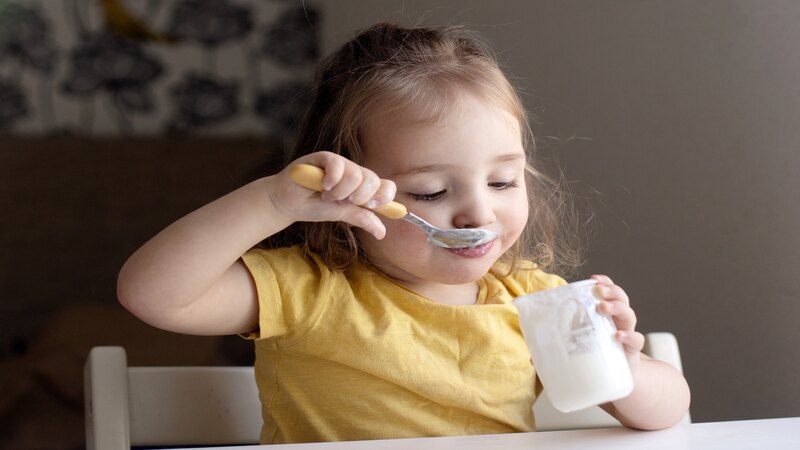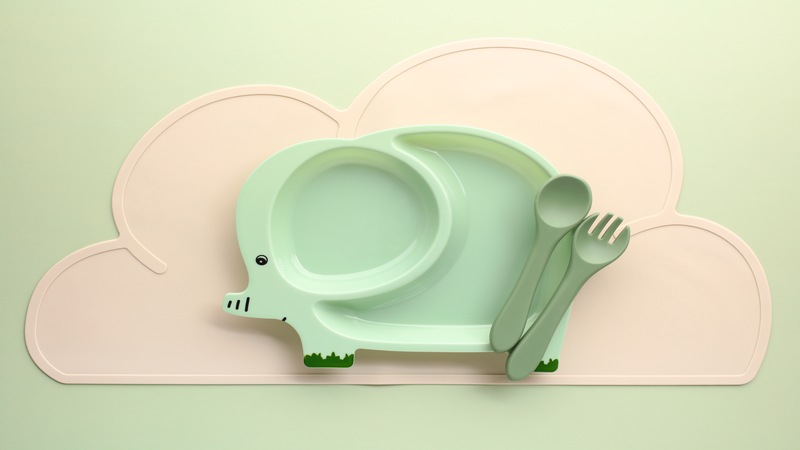
In today’s scenario, it’s essential to understand the unspoken customs and traditions of diverse cultures. Among these, ‘table manners and etiquette’ hold paramount importance. Parents should train toddlers on using fork and knife or proper ‘dining table etiquette’ from a tender age because this often leaves a lasting impression (1). Self-feeding is challenging, but you can make a big difference in a healthy way (2).
Parents with positive and caring attitudes ensure effortless learning (3). While using a spoon may be easy, mastering a knife and fork takes more time. Parents should introduce cutlery in three stages: first with a spoon, second with a spoon and fork, and lastly with a fork and knife. Hence, meal timings are the perfect opportunity to practice these skills (4).
When do Toddlers Start Using Cutlery?

Family mealtimes play a crucial role in developing toddlers to feed by themselves (5). Toddlers start acquiring self-feeding skills after six months (6), with most being able to use a spoon by age 2. By 3, they become used to forks. By age 5, they can spread and cut food with a knife (7).
Tips to help Your Toddlers Learn to Use a Fork And a Knife
Learning to use a knife and fork together can be difficult for toddlers. They need extra support and practice to coordinate both hands and perform movements smoothly and efficiently. Here are some tricks to help toddlers use the knife and fork correctly:
1. Be Ready With The Right Gear

Ensure to select a bib with a large and spacious pocket and a plate with non-slip rubber edges. Use cutlery shorter in length, making it easier for your toddlers. Opt for bright, appealing colors to make the dining experience exciting for your toddler.
2. Show The Method
Teach toddlers how to use utensils by demonstrating the correct technique and being patient. Avoid making fun of or scolding them for mistakes.
3. Let Them Practice a Lot
As a parent, you need lots of patience and perseverance. Make sure to let them practice eating with a knife and fork every day until it’s perfect.
4. Choices in Food

Feed your toddler a variety of foods to practice independence (8). Offer foods speared comfortably with a fork and cut into small pieces, like boiled potatoes. Avoid hard foods like meat and soft foods like bananas that may slip off the fork.
5. Be Ready For The Mess
Assure yourself that this practice will be messy in the beginning. It would be a good idea to position a floor mat just below the little one’s table so that clearing up becomes so much easier for you (9).
6. Praise Your Toddler
Commend your toddler’s efforts, even if they are messy (10). It boosts their confidence while handling a knife and fork to eat. Refrain from ridiculing or comparing toddlers as it impacts them negatively.
7. Never Force Your Toddler

Never force your toddler if they refuse to do it or show no interest. Leave it for a few days and commence it again. Pressurizing your toddler will not help.
8. Ensure You And Your Spouse Are Models
Remember your toddler is constantly watching what you do (11). Hence, it is crucial to eat right with the right fork and knife as your toddler imitates your behavior.
9. Practicing During Playtime
One good idea would be to conduct doll parties for your toddler, pretending to feed their teddy bears and dolls. Getting them to cut play dough is excellent practice for your toddler to learn this better (12).
10. Involve Your Toddler

You can involve toddlers in setting the table daily to teach them about the importance of cutlery during meals. Talking to them about each cutlery item and its purpose will help them understand the concept more quickly.
11. Be Ready to Find a Mixture of Fingers And Fork
There is every chance your toddler will prefer eating some foods with their fingers rather than using cutlery. It’s perfectly fine. Just leave them. As time passes, they will slowly develop the habit.
These pointers will make it easier to deal with your toddler’s cutlery use. Be assured, they will develop good table manners with proper training.
Tips to Assist Your Toddlers in Using Knife And Fork

It is important that your toddler is well positioned when they are learning any new skill, specifically when it is for using a fork and knife (13). There are some tips for you as parents to help your toddlers to make it successful:
-
- Ensure they are well-supported when sitting and using a fork and knife
-
- Set the dishes and utensils in the same way to create a routine. Use utensils with thick and textured handles
- Consider the weight of the cutlery
- Provide daily practice opportunities and encourage a good cutlery grasp from the start
- Work on one aspect of knife skills at a time and practice during other activities, like playing with play dough
Teaching toddlers good table manners is crucial for their social development. Using a knife and fork set fosters independence, promotes proper etiquette, and makes mealtimes engaging. Parents can set the foundation for lifelong healthy dining habits. Toddlers can learn the art of dining gracefully with proper guidance and safety measures (14).
FAQ’s
1. Why Does my 2-Year-Old Refuse to Use a Fork?
Every toddler is different and so are their capabilities. Hence, it is important not to push the toddler to use a fork unless they become comfortable. Else, the toddler will resist further.
2. How do I Introduce Cutlery to my Toddler?
This is usually done in a three-stage process – first with a spoon, then with a fork and spoon, and lastly fork and knife. It will help the toddler to practice more and focus on developing their coordinating skills.
References
-
- Brawley, Larra; Henk, Jennifer, Dimensions of Early Childhood, v42 n2 p18-22 2014 – https://eric.ed.gov/?id=EJ1044085
- Robert L. Nix, PhD; Lori A. Francis, PhD; Mark E. Feinberg, PhD; Sukhdeep Gill, PhD; Damon E. Jones, PhD; Michelle L. Hostetler, PhD; Cynthia A. Stifter, PhD, Pediatrics (2021) 147 (1): e20193326. https://doi.org/10.1542/peds.2019-3326 – https://publications.aap.org/pediatrics/article/147/1/e20193326/33444/Improving-Toddlers-Healthy-Eating-Habits-and-Self?
- Louise Rylatt, Tina Cartwright, Parental feeding behaviour and motivations regarding pre-school age children: A thematic synthesis of qualitative studies, Appetite, Volume 99, 2016,
Pages 285-297, ISSN 0195-6663, https://doi.org/10.1016/j.appet.2015.12.017. – https://www.sciencedirect.com/science/article/abs/pii/S0195666315301264 - Letizia Caronia, Vittoria Colla, Shaping a moral body in family dinner talk: Children’s socialization to good manners concerning bodily conduct, Appetite, Volume 199, 2024, 107502, ISSN 0195-6663, https://doi.org/10.1016/j.appet.2024.107502. – https://www.sciencedirect.com/science/article/pii/S0195666324003052
- Katherine Chandler, University of Maine at Farmington – https://scholarworks.umf.maine.edu/ech_projects/5/
- Kalhoff, H., Kersting, M., Sinningen, K. et al. Development of eating skills in infants and toddlers from a neuropediatric perspective. Ital J Pediatr 50, 110 (2024). https://doi.org/10.1186/s13052-024-01683-0 – https://link.springer.com/article/10.1186/s13052-024-01683-0
- NHS Greater Glasgow and Clyde – https://www.nhsggc.org.uk/kids/resources/ot-activityinformation-sheets/using-cutlery-information-sheet/
- Lynne Allison Daniels, Ann Nutr Metab (2019) 74 (Suppl. 2): 29–42., https://doi.org/10.1159/000499145 – https://karger.com/anm/article/74/Suppl.%202/29/42541
- Better Health Channel – https://www.betterhealth.vic.gov.au/health/healthyliving/toddlers-and-mealtime-manners
- Honig, Alice S.; Wittmer, Donna S. – https://eric.ed.gov/?id=ED291484
- Kim J, Oh S. The relationship between mothers’ knowledge and practice level of cough etiquette and their children’s practice level in South Korea. Child Health Nurs Res. 2021 Oct;27(4):385-394. doi: 10.4094/chnr.2021.27.4.385. Epub 2021 Oct 31. PMID: 35004526; PMCID: PMC8650946. – https://www.ncbi.nlm.nih.gov/pmc/articles/PMC8650946/
- Provide Children and Family Services – https://providechildrenandfamilyservices.co.uk/concerns/looking-after-themselves/using-cutlery/
- NHS Greater Glasgow and Clyde – https://www.nhsggc.org.uk/kids/resources/ot-activityinformation-sheets/sitting-at-the-table/
- Alexander KC Leung, Valérie Marchand, Reginald S Sauve, Canadian Paediatric Society, Nutrition and Gastroenterology Committee, Paediatrics & Child Health, Volume 17, Issue 8, October 2012, Pages 455–457, https://doi.org/10.1093/pch/17.8.455 – https://academic.oup.com/pch/article/17/8/455/2638933

